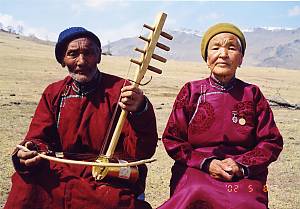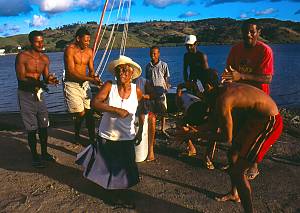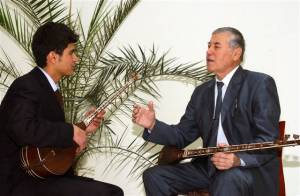The performing arts range from vocal and instrumental music, dance and theatre to pantomime, sung verse and beyond. They include numerous cultural expressions that reflect human creativity and that are also found, to some extent, in many other intangible cultural heritage domains.

© Sonom-Ish Yundenbat
Music is perhaps the most universal of the performing arts and is found in every society, most often as an integral part of other performing art forms and other domains of intangible cultural heritage including rituals, festive events or oral traditions. It can be found in the most diverse contexts: sacred or profane, classical or popular, closely connected to work or entertainment. There may also be a political or economic dimension to music: it can recount a community’s history, sing the praises of a powerful person and play a key role in economic transactions. The occasions on which music is performed are just as varied: marriages, funerals, rituals and initiations, festivities, all kinds of entertainment as well as many other social functions.
Dance, though very complex, may be described simply as ordered bodily movements, usually performed to music. Apart form its physical aspect, the rhythmic movements, steps and gestures of dance often express a sentiment or mood or illustrate a specific event or daily act, such as religious dances and those representing hunting, warfare or sexual activity.
Traditional theatre performances usually combine acting, singing, dance and music, dialogue, narration or recitation but may also include puppetry or pantomime. These arts, however, are more than simply ‘performances’ for an audience; they may also play crucial roles in culture and society such as songs sung while carrying out agricultural work or music that is part of a ritual. In a more intimate setting, lullabies are often sung to help a baby sleep.

© Luiz Santoz/UNESCO
The instruments, objects, artefacts and spaces associated with cultural expressions and practices are all included in the Convention’s definition of intangible cultural heritage. In the performing arts this includes musical instruments, masks, costumes and other body decorations used in dance, and the scenery and props of theatre. Performing arts are often performed in specific places; when these spaces are closely linked to the performance, they are considered cultural spaces by the Convention.
Many forms of performing arts are under threat today. As cultural practices become standardized, many traditional practices are abandoned. Even in cases where they become more popular, only certain expressions may benefit while others suffer.
Music is perhaps one of the best examples of this, with the recent explosion in the popularity of ‘World Music’. Though it performs an important role in cultural exchange and encourages creativity that enriches the international art scene, the phenomenon can also cause problems. Many diverse forms of music may be homogenized with the goal of delivering a consistent product. In these situations, there is little place for certain musical practices that are vital to the process of performance and tradition in certain communities.
Music, dance and theatre are often key features of cultural promotion intended to attract tourists and regularly feature in the itineraries of tour operators. Although this may bring more visitors and increased revenue to a country or community and offer a window onto its culture, it may also result in the emergence of new ways of presenting the performing arts, which have been altered for the tourist market. While tourism can contribute to reviving traditional performing arts and give a ‘market value’ to intangible cultural heritage, it can also have a distorting effect, as the performances are often reduced to show adapted highlights in order to meet tourist demands. Often, traditional art forms are turned into commodities in the name of entertainment, with the loss of important forms of community expression.In other cases, wider social or environmental factors may have a serious impact on performing art traditions. Deforestation, for example, can deprive a community of wood to make traditional instruments used to perform music.

© Otanazar Mat’yakubov
Many music traditions have been adapted to fit western forms of notation so they may be recorded, or for the purpose of education, but this process can be destructive. Many forms of music use scales with tones and intervals that do not correspond to standard western forms and tonal subtleties may be lost in the process of transcription. As well as music beinghomogenised, changes to traditional instruments to make them more familiar or easier to play for students, such as the addition of frets to stringed instruments, fundamentally alter the instruments themselves.
Safeguarding measures for traditional performing arts should focus mainly on transmission of knowledge and techniques, of playing and making instruments and strengthening the bond between master and apprentice. The subtleties of a song, the movements of a dance and theatrical interpretations should all be reinforced.
Performances may also be researched, recorded, documented, inventoried and archived. There are countless sound recordings in archives all around the world with many dating back over a century. These older recordings are threatened by deterioration and may be permanently lost unless digitized. The process of digitisation allows documents to be properly identified and inventoried.
Cultural media, institutions and industries can also play a crucial role in ensuring the viability of traditional forms of performing arts by developing audiences and raising awareness amongst the general public. Audiences can be informed about the various aspects of a form of expression, allowing it to gain a new and broader popularity, while also promoting connoisseurship which, in turn, encourages interest in local variations of an art form and may result in active participation in the performance itself.
Safeguarding may also involve improvements in training and infrastructure to properly prepare staff and institutions for preserving the full range of performing arts. In Georgia, students are trained in anthropological fieldwork methods as well as how to record polyphonies, allowing them to create the foundations of a national inventory by creating a database.